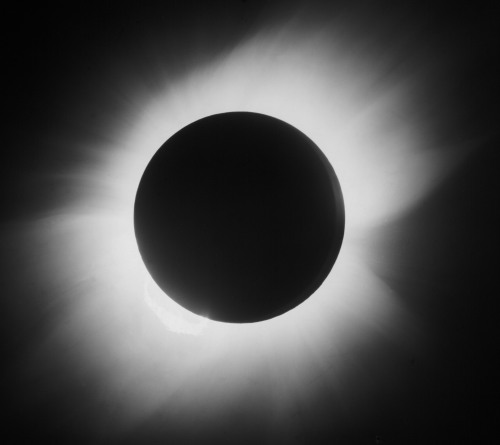7 Fascinating Facts About 2019’s Only Total Solar Eclipse










7 Fascinating Facts About 2019’s Only Total Solar Eclipse
“3.) Optimally situated viewers will experience 4 minutes and 33 seconds of totality. With Earth near aphelion and the Moon near perigee, it’s nearly twice the duration of 2017’s eclipse.”
On July 2, 2019, the world will experience a total solar eclipse: the only one of the year. Unlike the famous 2017 solar eclipse which spanned the continental United States, this year’s total solar eclipse occurs almost exactly coincident with both lunar perigee, where the Moon is closest to Earth, and solar aphelion, where the Sun is at its farthest point from Earth. July 2nd is just 2 days before our annual aphelion and 3 days before our monthly perigee, meaning that we’ll get 4 minutes and 33 seconds of totality during maximum eclipse: nearly twice as long as 2017′s maximum totality and the longest total solar eclipse we’ll experience until 2027.
What will we learn? What will we see? And how can you observe it from anywhere in the world? Find out these and more amazing facts before the eclipse passes!
More Posts from Ocrim1967 and Others










Not Only Didn’t We Find Water On An Earth-Like Exoplanet, But We Can’t With Current Technology
“Over the past few decades, astronomers have uncovered thousands of new exoplanets. Some of them are rocky; some are temperate; some have water. However, the idea that exoplanet K2-18b is rocky, Earth-like, and has liquid water is absurd, despite recent headlines. Light filters through K2-18b’s atmosphere when it passes in front of its star, enabling us to measure what’s absorbed. Based on those absorption lines, the presence of many chemicals can be inferred, including water. K2-18b is, truly, the first known habitable-zone exoplanet to contain water. However, it is not rocky; its mass and radius are too large, necessitating a large gas envelope around it.”
How incredible was that report that came out last week: the first Earth-like, rocky exoplanet with liquid water on its surface has been discovered! If it were true, it would be incredible. Well, what we did find is still pretty remarkable, but it’s very different from what you’ve likely heard.
We did find water on the exoplanet in question, K2-18b, but only in the vapor phase and only in the atmosphere.
The exoplanet is closer to Earth in terms of mass and radius than any other with water on it, but the planet is still too massive and large to be rocky. It must have an envelope of hydrogen and helium, and both have had their presence detected.
If we want to find atmospheric biosignatures around Earth-like worlds, we need better observatories. Let’s build them! Here’s the real story.
10 Things: How to Photograph a Meteor Shower
Taking photographs of a meteor shower can be an exercise in patience as meteors streak across the sky quickly and unannounced, but with these tips – and some good fortune – you might be rewarded with a great photo.
These tips are meant for a DSLR or mirrorless camera, but some point-and-shoot cameras with manual controls could be used as well.
1. The Photo Op: Perseids Meteors
The Perseids are dusty remnants of comet 109P/Swift-Tuttle.
Earth passes through the comet’s invisible, multi-billion mile trail of tiny debris each year around August, creating a meteor shower of so-called “shooting stars” as the particles are vaporized in our atmosphere.
Perseid meteors already are streaking across the sky. This year’s shower peaks on a moonless summer night -from 4 pm on the 12th until 4 am on the 13th Eastern Daylight Time.
Read more on the Perseids ›
2. Get away from city lights and find a place with dark skies.

In this 30 second exposure, a meteor streaks across the sky in Spruce Knob, West Virginia, during the 2016 Perseids meteor shower. Credit: NASA/Bill Ingalls
Too much light and it will be hard for your eyes to see fainter meteors, plus your image will get flooded with the glow of light. Turning down the brightness of the camera’s LCD screen will help keep your eyes adjusted to the dark. The peak of the 2018 Perseid meteor shower occurs just after the new moon, meaning a thin crescent will set long before the best viewing hours, leaving hopeful sky watchers with a moonlight-free sky!
3. Use a tripod.

In this ten-second exposure, a meteor streaks across the sky above Washington, DC during the 2015 Perseids meteor shower, Credit: NASA/Joel Kowsky
Meteor photography requires long exposures, and even the steadiest of hands can’t hold a camera still enough for a clear shot. Heavier tripods help reduce shaking caused by wind and footsteps, but even a lightweight tripod will do. You can always place sandbags against the feet of the tripod to add weight and stability. If you don’t have a tripod, you might be able to prop your camera on or up against something around you, but be sure to secure your camera.
4. Use a wide-angle lens.

In this 30 second exposure taken with a circular fish-eye lens, a meteor streaks across the sky during the 2016 Perseids meteor shower as a photographer wipes moisture from the camera lens Friday, August 12, 2016 in Spruce Knob, West Virginia. Credit: NASA/Bill Ingalls
A wide-angle lens will capture more of the sky and give you a greater chance of capturing a meteor in your shot, while a zoom lens captures a smaller area of the sky. The odds of a meteor streaking past that small patch are lower.
5. Use a shutter release cable or the camera’s built-in timer.

Long exposures are not just for meteors. In this shot taken at Joshua Tree National Park, a hiker’s headlamp leaves a trail of light along a twilight path. Credit: National Park Service / Hannah Schwalbe
A tripod does a great job of reducing most of the shaking your camera experiences, but even the act of pressing the shutter button can blur your extended exposure. Using the self-timer gives you several seconds for any shaking from pressing the shutter button to stop before the shutter is released. A shutter release cable (without a self-timer) eliminates the need to touch the camera at all. And if your camera has wifi capabilities, you might be able to activate the shutter from a mobile device.
6. Manually focus your lens.

In this 30 second exposure, a meteor streaks across the sky during the annual Perseids meteor shower Friday, August 12, 2016 in Spruce Knob, West Virginia. Credit: NASA/Bill Ingalls
At night, autofocus will struggle to find something on which to focus. Setting your focus to infinity will get you close, but chances are you’ll have to take some test images and do some fine tuning. With your camera on a tripod, take a test image lasting a few seconds, then use the camera’s screen to review the image. Zoom in to a star to see how sharp your focus is. If the stars look like fuzzy blobs, make tiny adjustments to the focus and take another test image.
Repeat until you are happy with the result.
If your camera has a zoomable electronic viewfinder or live view option, you might be able to zoom to a star and focus without having to take a test image.
7. Aim your camera.

The Perseids appear to radiate from the constellation Perseus, visible in the northern sky soon after sunset this time of year.
Even though we don’t know when or where a single meteor will appear, we do know the general area from which they’ll originate.
Meteor showers get their name based on the point in the sky from which they appear to radiate. In the case of the Perseids, during their peak, they appear to come from the direction of the constellation Perseus in the northern sky.
8. Calculate your exposure time.

In this 20-second exposure, a meteor lights up the sky over the top of a mountain ridge near Park City, Utah. Even though this image was captured during the annual Perseid meteor shower, this “shooting star” is probably not one of the Perseid meteors, which originate from material left behind by Comet Swift-Tuttle. Instead, it’s likely one of the many bits of rock and dust that randomly fall into the atmosphere on any given night. Credit: NASA/Bill Dunford
As Earth rotates, the stars in the sky appear to move, and if your shutter is open long enough, you might capture some of that movement. If you want to avoid apparent star movement, you can follow the 500 Rule. Take 500 and divide it by the length in millimeters of your lens. The resulting number is the length of time in seconds that you can keep your shutter open before seeing star trails. For example, if you’re using a 20 mm lens, 25 seconds (500 divided by 20) is the longest you can set your exposure time before star trails start to show up in your images.
9. Experiment!

In this 30 second exposure photo, hikers find their way to the top of Spruce Knob in West Virginia to view the annual Perseids meteor shower, Friday, August 12, 2016. Credit: NASA/Bill Ingalls
Once you know the maximum exposure time, you can set your shutter priority to that length and let the camera calculate other settings for your first image. Depending on how the image turns out, you can manually adjust aperture (set it to a lower number if the image is too dark) and ISO (set it to a higher number if the image is too dark) to improve your next images. Changing only one setting at a time will give you a better understanding of how those changes affect your image.
10. Enjoy the show.

The crew of the International Space Station captured this Perseid meteor falling to Earth over China in 2011. Credit: NASA
With your camera settings adjusted, capturing that perfect photo is just a matter of time and luck. The highest rate of meteors visible per hour is in the hours after midnight and before dawn. Set up your camera next to a lounge chair or a blanket to witness the wonder of a meteor shower for yourself – and, with any luck, you’ll take home some envy-inducing shots, too!
Make sure to follow us on Tumblr for your regular dose of space: http://nasa.tumblr.com.









‘’A God’s Eye View of the Universe’‘
Credit: SpaceRip










this cat is so cute



Happy Birthday, Albert Einstein! Genius Scientist Turns 140 Years Old Today.
The year 1905 came to be known as Einstein’s Miracle Year. He was 26 years old, and in that year he published four papers that reshaped physics.
Photoelectric effect
The first explained what’s called the photoelectric effect – one of the bases for modern-day electronics – with practical applications including television. His paper on the photoelectric effect helped pave the way for quantum mechanics by establishing that light is both a particle and a wave. For this work, Einstein was later awarded a Nobel Prize in physics.


Brownian motion
Another 1905 paper related to Brownian motion. In it, Einstein stated that the seemingly random motion of particles in a fluid (Brownian motion) was a predictable, measurable part of the movement of atoms and molecules. This helped establish the Kinetic Molecular Theory of Heat, which says that, if you heat something, its molecules begin to vibrate. At this same time, Einstein provided definitive confirmation that atoms and molecules actually exist.


Special relativity
Also in 1905, Einstein published his Special Theory of Relativity. Before it, space, time and mass all seemed to be absolutes – the same for everyone. Einstein showed that different people perceive mass, space and time differently, but that these effects don’t show up until you start moving nearly at the speed of light. Then you find, for example, that time on a swiftly moving spaceship slows down, while the mass of the ship increases. According to Einstein, a spaceship traveling at the speed of light would have infinite mass, and a body of infinite mass also has infinite resistance to motion. And that’s why nothing can accelerate to a speed faster than light speed. Because of Einstein’s special relativity, light is now seen as an absolute in a universe of shifting values for space, time and matter.

Mass-energy equivalence
The fourth 1905 paper stated that mass and energy are equivalent. You perhaps know something of this work in Einstein’s famous equation E=mc2. That equation means that energy (E) is equal to mass (m) multiplied by the speed of light © squared. Sound simple? It is, in a way. It means that matter and energy are the same thing. It’s also very profound, in part because the speed of light is a huge number. As shown by the equation, a small amount of mass can be converted into a large amount of energy … as in atomic bombs. It’s this same conversion of mass to energy, by the way, that causes stars to shine.
But Einstein didn’t stop there. As early as 1911, he’d predicted that light passing near a large mass, such as a star, would be bent. That idea led to his General Theory of Relativity in 1916.


This paper established the modern theory of gravitation and gave us the notion of curved space. Einstein showed, for example, that small masses such as planets form dimples in space-time that hardly affect the path of starlight. But big masses such as stars produce measurably curved space.





The fact that the curved space around our sun was measurable let other scientists prove Einstein’s theory. In 1919, two expeditions organized by Arthur Eddington photographed stars near the sun made visible during a solar eclipse. The displacement of these stars with respect to their true positions on the celestial sphere showed that the sun’s gravity does cause space to curve so that starlight traveling near the sun is bent from its original path. This observation confirmed Einstein’s theory, and made Einstein a household name.

Source (read more) posts about Einstein
Far from Westeros, a Three-Eyed Raven Helps NASA Find Its Way
Perched on the outside of the International Space Station is Raven—a technology-filled module that helps NASA develop a relative navigation capability, which is essentially autopilot for spacecraft. Raven has been testing technologies to enable autonomous rendezvous in space, which means the ability to approach things in space without human involvement, even from the ground.

Developed by the Satellite Servicing Projects Division (SSPD), our three-eyed Raven has visible, infrared, and Lidar sensors and uses those “eyes” to image and track visiting spacecraft as they come and go from the space station. Although Raven is all-seeing, it only sees all in black and white. Color images do not offer an advantage in the case of Raven and Restore-L, which also utilize infrared and Lidar sensors.
The data from Raven’s sensors is sent to its processor, which autonomously sends commands that swivel Raven on its gimbal, or pointing system. When Raven turns using this system, it is able to track a vehicle. While these maneuvers take place, NASA operators evaluate the movements and make adjustments to perfect the relative navigation system technologies.

A few days ago, Raven completed its 21st observation of a spacecraft when it captured images of Northrop Grumman’s Cygnus vehicle delivering science investigations and supplies as part of its 11th commercial resupply services mission, including another SSPD payload called the Robotic External Leak Locator.

And just last month, Raven celebrated its two-year anniversary in space, marking the occasion with an observation of SpaceX’s Crew Dragon during the Demo-1 mission.

What is this—a spacecraft for ants??
While this shot of Dragon isn’t terribly impressive because of where the spacecraft docked on station, Raven has captured some truly great images when given the right viewing conditions.
From SpaceX Dragon resupply mission observations…

…to Cygnus supply vehicles.

Raven has observed six unique types of spacecraft.
It has also conducted a few observations not involving spacecraft, including the time it captured Hurricane Irma…

…or the time it captured station’s Dextre arm removing the Robotic Refueling Mission 3 payload, another mission developed by SSPD, from the Dragon spacecraft that delivered it to the orbiting laboratory.


Thus far, Raven has had a great, productive life aboard the station, but its work isn’t done yet! Whether it’s for Restore-L, which will robotically refuel a satellite, or getting humans to the Moon or Mars, the technologies Raven is demonstrating for a relative navigation system will support future NASA missions for decades to come.

Make sure to follow us on Tumblr for your regular dose of space: http://nasa.tumblr.com










FOR SALE: Mobile &Web Illustration


HiPOD (31 August 2018) Dunes in South Xainza Crater
– They look so innocent… (270 km above the surface. Black and white is less than 5 km across; enhanced color is less than 1 km.)
NASA/JPL/University of Arizona


Chandra Spots Extremely Long Cosmic Jet in Early Universe
http://www.sci-news.com/astronomy/chandra-extremely-long-cosmic-jet-early-universe-09436.html
-
 looookingup reblogged this · 11 months ago
looookingup reblogged this · 11 months ago -
 sandrodelgado47-blog liked this · 5 years ago
sandrodelgado47-blog liked this · 5 years ago -
 samuel-31 liked this · 5 years ago
samuel-31 liked this · 5 years ago -
 maybethistime2 liked this · 5 years ago
maybethistime2 liked this · 5 years ago -
 limex456 reblogged this · 5 years ago
limex456 reblogged this · 5 years ago -
 tinytinyturtles liked this · 5 years ago
tinytinyturtles liked this · 5 years ago -
 george-with-a-j liked this · 5 years ago
george-with-a-j liked this · 5 years ago -
 poporano liked this · 5 years ago
poporano liked this · 5 years ago -
 limex456 reblogged this · 5 years ago
limex456 reblogged this · 5 years ago -
 limex456 liked this · 5 years ago
limex456 liked this · 5 years ago -
 love-sparklydreamangel-blog liked this · 5 years ago
love-sparklydreamangel-blog liked this · 5 years ago -
 dreamer-in-paradise-lost-blog liked this · 5 years ago
dreamer-in-paradise-lost-blog liked this · 5 years ago -
 rosotova reblogged this · 5 years ago
rosotova reblogged this · 5 years ago -
 atropabelledonna-blog liked this · 5 years ago
atropabelledonna-blog liked this · 5 years ago -
 triplealovely liked this · 5 years ago
triplealovely liked this · 5 years ago -
 stamatijordan liked this · 5 years ago
stamatijordan liked this · 5 years ago -
 heartstabbers liked this · 5 years ago
heartstabbers liked this · 5 years ago -
 classydreammoneywombat-blog liked this · 5 years ago
classydreammoneywombat-blog liked this · 5 years ago -
 friedbanditlandcookie-blog liked this · 5 years ago
friedbanditlandcookie-blog liked this · 5 years ago -
 beauti-ash liked this · 5 years ago
beauti-ash liked this · 5 years ago -
 mafaldinablabla liked this · 5 years ago
mafaldinablabla liked this · 5 years ago -
 angrygoomba reblogged this · 5 years ago
angrygoomba reblogged this · 5 years ago -
 angrygoomba liked this · 5 years ago
angrygoomba liked this · 5 years ago -
 demonio-psychosocial reblogged this · 5 years ago
demonio-psychosocial reblogged this · 5 years ago -
 demonio-psychosocial liked this · 5 years ago
demonio-psychosocial liked this · 5 years ago -
 youweremyridehome reblogged this · 5 years ago
youweremyridehome reblogged this · 5 years ago -
 greendalek reblogged this · 5 years ago
greendalek reblogged this · 5 years ago -
 ammon-rah liked this · 5 years ago
ammon-rah liked this · 5 years ago -
 greendalek liked this · 5 years ago
greendalek liked this · 5 years ago -
 estadoencrisis reblogged this · 5 years ago
estadoencrisis reblogged this · 5 years ago -
 angelicjupiter liked this · 5 years ago
angelicjupiter liked this · 5 years ago -
 aramadriel-blog reblogged this · 5 years ago
aramadriel-blog reblogged this · 5 years ago -
 aramadriel-blog liked this · 5 years ago
aramadriel-blog liked this · 5 years ago -
 angelicvibrations liked this · 5 years ago
angelicvibrations liked this · 5 years ago -
 lissleta liked this · 5 years ago
lissleta liked this · 5 years ago -
 maru7094 reblogged this · 5 years ago
maru7094 reblogged this · 5 years ago -
 myadrenalinepearls liked this · 5 years ago
myadrenalinepearls liked this · 5 years ago -
 sailears reblogged this · 5 years ago
sailears reblogged this · 5 years ago -
 sailears liked this · 5 years ago
sailears liked this · 5 years ago -
 sativazo liked this · 5 years ago
sativazo liked this · 5 years ago